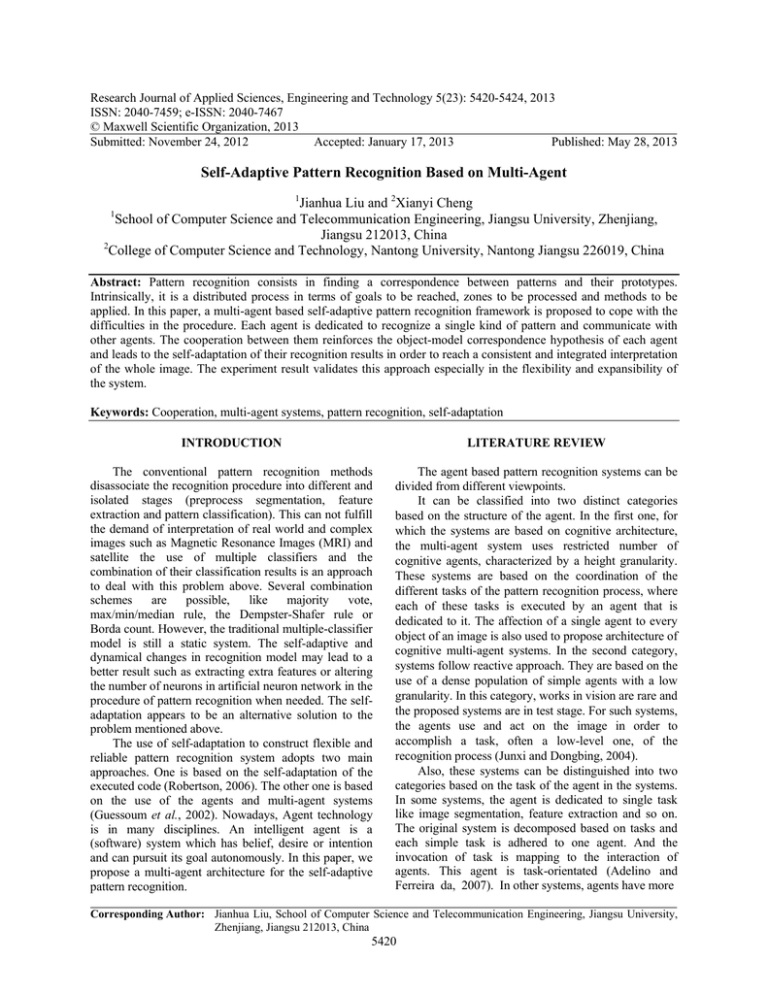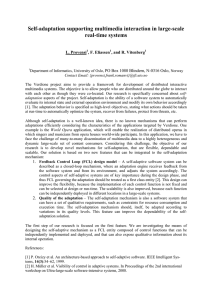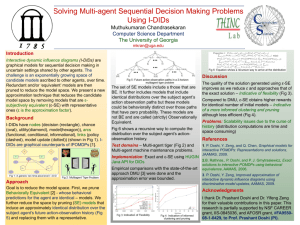Research Journal of Applied Sciences, Engineering and Technology 5(23): 5420-5424,... ISSN: 2040-7459; e-ISSN: 2040-7467
advertisement

Research Journal of Applied Sciences, Engineering and Technology 5(23): 5420-5424, 2013 ISSN: 2040-7459; e-ISSN: 2040-7467 © Maxwell Scientific Organization, 2013 Submitted: November 24, 2012 Accepted: January 17, 2013 Published: May 28, 2013 Self-Adaptive Pattern Recognition Based on Multi-Agent 1 Jianhua Liu and 2Xianyi Cheng School of Computer Science and Telecommunication Engineering, Jiangsu University, Zhenjiang, Jiangsu 212013, China 2 College of Computer Science and Technology, Nantong University, Nantong Jiangsu 226019, China 1 Abstract: Pattern recognition consists in finding a correspondence between patterns and their prototypes. Intrinsically, it is a distributed process in terms of goals to be reached, zones to be processed and methods to be applied. In this paper, a multi-agent based self-adaptive pattern recognition framework is proposed to cope with the difficulties in the procedure. Each agent is dedicated to recognize a single kind of pattern and communicate with other agents. The cooperation between them reinforces the object-model correspondence hypothesis of each agent and leads to the self-adaptation of their recognition results in order to reach a consistent and integrated interpretation of the whole image. The experiment result validates this approach especially in the flexibility and expansibility of the system. Keywords: Cooperation, multi-agent systems, pattern recognition, self-adaptation INTRODUCTION LITERATURE REVIEW The conventional pattern recognition methods disassociate the recognition procedure into different and isolated stages (preprocess segmentation, feature extraction and pattern classification). This can not fulfill the demand of interpretation of real world and complex images such as Magnetic Resonance Images (MRI) and satellite the use of multiple classifiers and the combination of their classification results is an approach to deal with this problem above. Several combination schemes are possible, like majority vote, max/min/median rule, the Dempster-Shafer rule or Borda count. However, the traditional multiple-classifier model is still a static system. The self-adaptive and dynamical changes in recognition model may lead to a better result such as extracting extra features or altering the number of neurons in artificial neuron network in the procedure of pattern recognition when needed. The selfadaptation appears to be an alternative solution to the problem mentioned above. The use of self-adaptation to construct flexible and reliable pattern recognition system adopts two main approaches. One is based on the self-adaptation of the executed code (Robertson, 2006). The other one is based on the use of the agents and multi-agent systems (Guessoum et al., 2002). Nowadays, Agent technology is in many disciplines. An intelligent agent is a (software) system which has belief, desire or intention and can pursuit its goal autonomously. In this paper, we propose a multi-agent architecture for the self-adaptive pattern recognition. The agent based pattern recognition systems can be divided from different viewpoints. It can be classified into two distinct categories based on the structure of the agent. In the first one, for which the systems are based on cognitive architecture, the multi-agent system uses restricted number of cognitive agents, characterized by a height granularity. These systems are based on the coordination of the different tasks of the pattern recognition process, where each of these tasks is executed by an agent that is dedicated to it. The affection of a single agent to every object of an image is also used to propose architecture of cognitive multi-agent systems. In the second category, systems follow reactive approach. They are based on the use of a dense population of simple agents with a low granularity. In this category, works in vision are rare and the proposed systems are in test stage. For such systems, the agents use and act on the image in order to accomplish a task, often a low-level one, of the recognition process (Junxi and Dongbing, 2004). Also, these systems can be distinguished into two categories based on the task of the agent in the systems. In some systems, the agent is dedicated to single task like image segmentation, feature extraction and so on. The original system is decomposed based on tasks and each simple task is adhered to one agent. And the invocation of task is mapping to the interaction of agents. This agent is task-orientated (Adelino and Ferreira da, 2007). In other systems, agents have more Corresponding Author: Jianhua Liu, School of Computer Science and Telecommunication Engineering, Jiangsu University, Zhenjiang, Jiangsu 212013, China 5420 Res. J. App. Sci. Eng. Technol., 5(23): 5420-5424, 2013 Fig. 1: Agent types in pattern recognition integrated capability to perform recognition which means they can do pattern recognition all by their own. Each agent stands for an object in the image and has correspondent model of this object. The relationship among objects in the image is mapping to the interaction and self-adaptation of these agents. This agent is objectorientated. These schemes of agents used in pattern recognition can be shown in Fig. 1. Literature (Luo et al., 2003) has proposed a cognitive multi-agent system, for the surveillance of dynamical scenes. The authors associate to every object of the analyzed scene, a single agent. It belongs to cognitive and object-orientated. The system uses a Bayesian network to infer semantics of the movements of the different objects. For every object of the scene, a behavior agent is created to operate at the object level. The multi-agent system proposed by Luo et al. (2003) is the best sample of the reactive systems. Using the colonies of artificial ants, the system performs the segmentation of a gray level image, by considering it as an environment in which move the ants. It belongs to reactive and task-orientated agent. Fig. 2: Agent architecture • • • THE ARCHITECTURE OF MULTI-AGENT BASED SELF-ADAPTIVE PATTERN RECOGNITION In our architecture the system is constructed as an assembly of autonomous agents that perform pattern recognition from an image independently. It is a flexible and expansible framework which can change the capability of agents to recognize different kinds of images or add more agents to recognize different types of objects in an image. Intelligent agents for pattern recognition: Individual agents are characterized by immaterial notions and their social behaviors in agent societies. Belief, desire and intention are the basic mental characteristics of intelligent agents. They design the popular BDI agents (Duchesnay et al., 2003). Based on this idea, the structure of our agent for performing pattern recognition task is shown in Fig. 2. As shown, the architecture is composed of six different modules: • • o o o Plan Module (PM): This module is used for storing basic planning strategies. They are stored in facts and rules that are applicable in different situations and determine the general behavior of 5421 agents. PM is a part of knowledge base which is called belief set in BDI model owned by agents. Information System (IS): Information system is used to store the information sensed by the agent in the environment which changes as time because of the execution of agent’s behavior. In terms of pattern recognition, a main part of IS is the current recognition result and some general knowledge about its task. The IS and PM constitute the belief set of agent. Object Model (OM): The object is dedicated to be recognized in the environment. In our system, only one kind of object can be recognized by an agent. Each OM becomes more and more exact through the self-adaptive recognition procedure although the initial OM is abstract and imprecise. OM denotes the goals that agent wants to achieve and so forms the intention in BDI model. Pattern Recognition Module (PRM): PRM is used to execute some operations on the environment that the agent situated to exhibit the behavior of agent. It includes many traditional pattern recognition methods like kNN approach and fuzzy recognition method. Agent selects some methods to carry out and gains its recognition result. Inference Engine (IE): Based on plan module, information system and object model, the inference engine accomplishes all planning and interpretation tasks of the agent. It is the kernel of the agent. In detail, it is mainly responsible for: The choose of pattern recognition module, this can be described by PM × IS × OM -> PRM. It demonstrates how the intention is chosen based on the belief set and the desire of the agent. The impact of the performing of PRM, this is depicted by PRM×IS->IS, which implies how the PRM can effect the information system and the recognition result. The influence of the performing of PRM on the object model of the agent this can by described by PRM×IS->OM. The process describing how the incremental refinement of interpretation is obtained through a from coarse to fine strategy. The above is the main function of inference engine. Res. J. App. Sci. Eng. Technol., 5(23): 5420-5424, 2013 Fig. 4: The relationship between model-based recognition and model-parameters estimation Fig. 3: Communication among agents The functions involved above are explained bellow: • • Communication Module (CM): This module is responsible for connecting to other agents. It contains methods for sending and receiving messages as well as functions for wrapping various data types, which are required to solve the particular tasks which belong to the agent. The communication among agents: In our system we propose a blackboard agent for communication among the agents. Thus, in stead of using directly point-to-point communication among the recognition agents, information is written to a blackboard that actively distributes the information to other agents (Fig. 3). THE COOPERATION AMONG AGENTS Recognition flow: The behavior of agent can be described in pseudo-code bellow and it is the main function of inference engine of pattern recognition agent based on BDI model: • • • • • • • • • • Update (IS, p): Update the belief set of the agent based on perception. Option (IS, OM): Generate desires based on IS and OM. Filter (IS, D, OM): Select one to form intention from desires. Plan (IS, OM, PRM): Choose a plan based on IS, OM and PRM. Empty (π): Check if the current plan is empty. Succeeded (IS, OM): Check if the OM is implemented in recognition process. Impossible (IS, OM): Check if the OM is a wrong intention. Head (π): Extract the first action of the plan π. Execute (α); execute the action α. Tail (π): extract all other actions in plan π except the first action. Reconsider (IS, OM): check if it is needed to reconsider the desire and intention of the agent. Sound (π, IS, OM): check if the current plan π is valid under the situation of IS and OM. • IS←IS0; OM←OM0; while true do The cooperation among agents: The individual receive perception p from blackboard; recognition capability of agent is the basis of our IS←Update(IS, p); system, however, the cooperation among agents is the D←Option(IS, OM); kernel to implement self-adaptive pattern recognition OM←Filter(IS, D, OM); and gain better results. There are several mechanisms π←Plan(IS, OM, PRM); used for cooperation in our system. They have been while not(empty(π) or succeeded(IS, OM) or implemented in the functions above. impossible(IS, OM)) do α←Head(π); • Model-based recognition: Agent performs its execute (α); recognition based on its Object Model (OM). π←Tail(π); • Model-parameter estimation: Because the request perception p from blackboard recognition process is from coarse to fine and the IS←Update(IS,p); feature needed for recognition is extracted if reconsider(IS, OM) then gradually, the parameters of agent’s object model D←Option(IS, OM); are estimated step by step and become more and OM←Filter(IS, D, OM); more accurate based on the pattern which has been end-if recognized. The relationship between the two if not sound(π, IS, OM) then mechanics is shown in Fig. 4. π←Plan(IS, OM, PRM); • Information fusion: When an agent accomplishes end-if its task, it will send its result to the blackboard end-while agent so that the other agents who would be if succeeded(IS, OM) then interested in it can fuse it with its own IS to enhance inform Blackboard Agent result the recognition capability of that agent. In order to end-while fuse knowledge from different sources, the 5422 Res. J. App. Sci. Eng. Technol., 5(23): 5420-5424, 2013 algorithm to do the model-parameter estimation. The original MRI and the segmentation results are shown in Fig. 5. We construct four kinds of agents (corresponding to background, gray matter, white matter, cerebrospinal fluid respectively) to execute the segmentation. From the results, we can see the MRI has been segmented appropriately. CONCLUSION AND RECOMMENDATIONS Fig. 5: The original MRI and the segmentation results • • information obtained must be modeled in a common framework that manages imprecision and uncertainty. A Bayesian probabilistic framework is most often consider-ed. Uncertainty and imprecision modeling may also be introduced, using fuzzy, or possibilities approaches. Conflict resolution: “Conflict” means that exists the region where two or more object candidates are assigned or the pattern is classified into different classes by different agents. When a conflict occurs, the concerning agents compare the evaluation with the results and cancel one Adapt recognition results based on the relationship among patterns: In general, there always exist some relationships or constrains between the patterns in an image. For example, because of the impact of gravity, all objects except the background object must be supported by other objects in the real world. We can utilize this knowledge to verify the recognition result. This mechanism will help to keep the consistency of interpretation of the whole image or recognition results to implement our self-adaptive pattern recognition in despite of the local capability of agents. EXPERIMENTAL RESULTS In this study, we propose a multi-agent based selfadaptive pattern recognition system to do complex recognition task. The self-adaptation of agents derived from their cooperation results that the agents gain a consistent interpretation of the whole image although each agent only have the capability of recognizing a single kind of object in the image. Multi-agent approach proves to be a promising method for pattern recognition. There are several reasons for this conclusion: • • • It focuses on the parallel and distributed characteristics of the pattern recognition process which have been ignored by traditional methods. It introduces the self-adaptation and dynamic mechanisms into the recognition procedure avoiding the statics and rigidity of normal systems. It makes the system can be expanded easily without rebuilding the whole system and only need to add new agent into the existed system. Future research will concentrate on the several aspects that enhance the flexibility and applicability of our system furthers especially the more efficient learning strategy of the agent. REFERENCES Adelino, R. and S. Ferreira da, 2007. A dirichlet process mixture model for brain MRI tissue classification. Med. Image Anal., 11: 169-182. Duchesnay, E., M. Jean-Jacques and J. Yann, 2003. Cooperative agents society organized as an irregular pyramid: A mammography segmentation application [J]. Pattern Recogn. Lett., 21(14): 2435-2445. Guessoum, Z., J.P. Briot, S. Charpe0ntier, O. Marin and P. Sens, 2002. A fault-tolerant multi-agent framework. Proceeding of 1st International Joint Conference on AAMAS, pp: 672-673. Junxi, S. and G. Dongbing, 2004. Bayesian image segmentation based on an inhomogeneous hidden markov random field [C]. Proceeding of the 17th International Conference on Pattern Recognition, pp: 1051-4651. The segmentation of Magnetic Resonance Images (MRI) is a difficult task for traditional image processing approaches because of its huge data, complexity and high variety of the tissue or anatomical structure and the high variability and low specificity of the radiometric distribution. In order to validate our approach, we implement an experimental system to segment MRI using C++ and PVM (parallel virtual machine) (Zeyun and Chandrajit, 2002). The basic structure of agent is described above. In order to segment different tissues, we introduce a hidden Markov random field to model the tissue and the Expectation-Maximization (EM) 5423 Res. J. App. Sci. Eng. Technol., 5(23): 5420-5424, 2013 Luo, Y., K. Liu and D.N. Davis, 2003. A multi-agent decision support system for stock trading [J]. IEEE Netw., 16(1): 20-27. Robertson, P., 2006. Anarchitecture for self-adaptation and its application to aerial image understanding. Internal Report, Oxford. Zeyun, Y. and B. Chandrajit, 2002. Image segmentation using gradient vector diffusion and region merging [C]. Proceeding of the 16th International Conference on Pattern Recognition. Quebec, Canada, pp: 941-944. 5424





